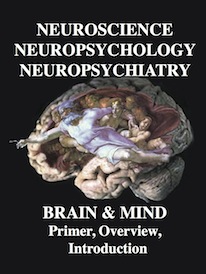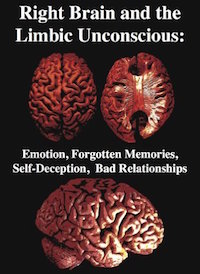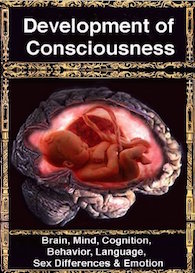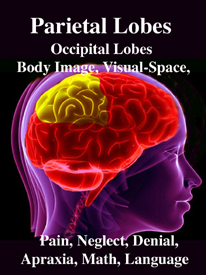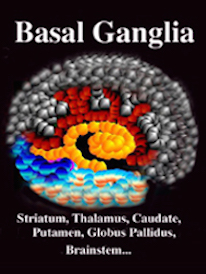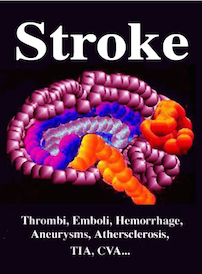Rhawn Gabriel Joseph
BrainMind.com
Dr: "Give me your left hand!"
(The patient presents the right hand. The doctor takes hold of the right hand.)
Dr: "Give me your left hand!" (The patient looked puzzled and did not move.)
Dr: "Is there anything wrong with your left hand?"
Pt: "No, doctor."
Dr. "Why don't you move it, then?" (The left hand was held before her eyes.)
Pt.: "I don't know."
Dr: "Is this your hand?"
Pt: "Not mine, doctor."
Dr: "Whose hand is it, then?"
Pt: "I supposed it's yours, doctor."
Dr: "No, it's not. I've already got two hands. Look at it carefully."
Pt. "It is not mine, doctor."
Dr: "Yes it is, look at that ring; whose ring is it?"
Pt.: "That's my ring; you've got my ring, doctor."
Dr: "Look at it--it is your hand.
Pt: "Oh, no doctor."
Dr: "Where is your left hand then?"
Pt: "Somewhere here, I think."
(Making groping movements near her left shoulder.) (Adapted from Sandifer, 1946).
With massive destruction of the visual cortex, patients may deny blindness. However, with massive destruction of the right superior parietal lobe--a neocortical area which maintains a memory of the body image--patients may deny the existence of half their body (Bisiach, & Geminiani, 2011; Critchley, 1953; Heilman, 2007; Sandifer, 1946).
The primary somatosensory areas receives somesthetic and proprioceptive stimuli (Kaas, 2007; Kaas, Nelson, Sur, & Merzenich, 2002). However, because the right parietal lobe maintains a bilateral memory-image of the body (whereas the left lobe maintains only a right sided-body image), if destroyed, all left-sided somatosensory memories may be abolished and the language axis will become amnesic for half the body (Joseph, 1986a); a condition also referred to as unilateral neglect and inattention.
These patients (i.e. the intact left hemisphere) will also fail to comb, wash, or dress the left half of their head, face, and body, and when shown their left arm or leg, they may claim that it belongs to the doctor or a patient in the next room. Indeed, "patients with severe unilateral neglect behave as if a whole system of beliefs have vanished, as if one half of the inner model of the environment were simply deleted from their mind (Bisiach et al., 1983, p. 35).
THE ALIEN HAND
Because all memories of the left side of the body are abolished, the language axis may fill the gap in its knowledge by referring to their left side with ego-alien language, attributing its presence to relatives, a patient in the next room, or the doctor. For example, Gerstmann (1942) describes a patient who "did not realize and on being questioned denied, that she was paralyzed on the left side of the body, did not recognize her left limbs as her own, ignored them as if they did not exist, and entertained confabulatory and delusional ideas in regard to her left extremities. She said another person was in bed with her, a little Negro girl, whose arm had slipped into the patient's sleeve" (p. 894). Another declared, (speaking of her left limbs), "That's an old man. He stays in bed all the time."
Another patient engaged in peculiar erotic behavior with his left limbs which he believed belonged to a woman. A patient described by Bisiach and Berti (1987, p. 185) "would become perplexed and silent whenever the conversation touched upon the left half of his body; even attempts to evoke memories of it were unsuccessful." Moreover, although "acknowledging that all people have a right and a left side, he could not apply the notion to himself. He would affirm that a woman was lying on his left side; he would utter witty remarks about this and sometimes caress his left arm".
Some patients may develop a dislike for their left limbs, try to throw them away, become agitated when they are referred to, entertain persecutory delusions regarding them, and even complain of strangers sleeping in their beds (Bisiach & Berti, 1987; Critchley, 1953; Gerstmann, 1942). Likewise, the left hemisphere of some split-brain patients may verbally claim to hate the left half of their body and attribute to it disagreeable personality traits or claim that it has engaged in behavior which the speaking half of the brain finds unpleasant, strange, objectionable, embarrassing, or contrary to it's wishes (Joseph, 1988ab).
Moreover, just a the left hemisphere of some "split-brain" patients may view the left half of the body as being controlled by a separate personality, patients with massive right parietal lesions may react in a similar fashion when confronted with their left arms and legs. One woman who was confronted with her paralyzed left arm said it belonged to another person whom she thought was in bed with her. Another declared (speaking of her left limbs), "That's an old man. He stays in bed all the time."
One patient complained that this other person tried to push her out of the bed and threatened to sue the hospital. Another complained about "a hospital that makes people sleep together." Another patient, after bumping into her left arm and leg all night, bitterly complained about "a hospital that makes people sleep together." She expressed not only anger but concern least her husband should find out; she was convinced it was a man in her bed.
As discussed and detailed in chapter 10, the right hemisphere is dominant for the establishment of emotional and personal memories, including memories associated with the body image which are maintained in the right parietal lobe. Hence, with massive right parietal injuries all memories of the left half of the body are erased, resulting in a dissociative amnesia for half of the body.
Essentially, with massive right parietal lesions, the left hemisphere and language dependent aspects of consciousness aree denied access to all memories regarding the left half of the body which have been destroyed. In consequence, the left hemisphere may be unable to recognize or remember the left half of their body as all memories have been erased. The language axis of the intact left hemisphere, when confronted with the left half of their body, will experiences it as completely alien and as perhaps belonging to someone else, such as the examining physician. That is, the language axis may fill the gaps in its knowledge and available memories by making up explanations which it accepts as truth. It conjures up false memories; confabulations which go uncorrected as all associated memories regarding the left half of the body have been erased from consciousness.
THE MEDIAL FRONTAL LOBE & THE ALIEN HAND: MAGNETIC APRAXIA
Forced Grasping & Groping.
As detailed in the chapters on the frontal lobes, the medial lobe receives and projects to wide areas of the neocortex and is involved in movement initiation and programming. Hence, with extensive injuries the patient may cease to move or speak. However, with less extensive injuries the ability to voluntarily control one's movements may be compromised, such that the arms and hands become freed of internal control. That is, they may respond involuntarily to external stimuli by reaching out, touching, grasping, or even utilizing whatever they touch (Denny-Brown, 1958; Gasquoine 2007; Goldberg & Bloom 1990; Lhermitte, 1983; Travis, 1955). Presumably this is due to a loss of internal motivational controls (i.e. disconnection), and is partially a release phenomenon such that patients appear reflexively or magnetically directed solely by external stimuli which trigger involuntary motor reactions.
For example, with extensive destruction and/or as the lesion extends mesially, the mere visual presence of an object near the hand triggers groping movements as well as grasping. Similarly, if an object touches the palm of the hand, the patient grips it involuntarily and cannot let go. Denny-Brown (1958) has referred to this as "magnetic apraxia" and "complusive exploration". He notes that touching the hand will elicit orienting movements to bring the object into the palm. Once it is grasped the patient cannot release his grip.
This aberration is often accompanied by gegenhalten. Immediately prior to actually grasping the object the entire arm will stiffen and one is met with resistance if an attempt is made to move the extremity. If a patient were to attempt to write, the hand stiffens and becomes seemingly "stuck" to the paper. If they try to walk, their feet seem to stick to the floor as if glued, and steps are made with great difficulty (Denny-Brown, 1958).
Denny-Brown (1958) believed that magnetic groping was due in part to a perseveration of contractual reactions (as well as parietal lobe disinhibitory release), for so long as stimulation is applied to the skin, the deficit, including gegenhalten, not only persists but becomes more intense.
This abnormality is also triggered visually. As if stimulus bound, the patients eyes and head may compulsively following moving objects. If an object is brought near the face they may compulsively reach out and take it, and/or if near the lips may attempt to mouth or suck it. Such behavior is completely involuntary and will occur even if the patient "Willfully" attempts to oppose it.
Presumably this is due to a disconnection involving the medial and the lateral frontal lobes. That is, since the medial area does not normally respond to visual input whereas the lateral area does (Passingham, 2007), lesions to the medial area may result in the disinhibition of the lateral motor areas which compulsively respond to visual stimuli.
Patients may involuntarily pick up and compulsively utilize various tools, utensils and other objects, and may compulsively reach out and take the examiner's pen or swipe their glasses from their face and put them on. One patient put three pair of spectacles on and wore them simultaneously (Lhermitte 1983).
If a hammer or glass of water is placed on the testing table the patient may involuntarily begin to hammer, or they may drink from the glass although they are not thirsty and when told to refrain from these behaviors (Denny-Brown 1958; Lhermitte 1983; McNabb et al. 1988; Travis 1955). Hence, damage is this area can cause patients to respond and use whatever objects or tools may be close even when they understand that they are not to do so (Lhermitte, 1983).In fact, these involuntary movements may become so purposeful and complex and uncontrolled that this condition has also been referred to as the "alien hand" (Feeman and Watts 1942; Gasquoine 2007; Goldberg and Bloom 1990; Joseph 1988ab; Travis 1955).
DUAL MENTAL FUNCTIONING AND THE ALIEN HAND
As is well known, the right versus the left hemisphere controls the left versus the right hand and subserves different aspects of conscious experience, e.g. emotion, visual spatial functioning, and non-verbal memory (Borod et al., 1992; Brewer et al., 1998; Cimino et al., 2011; Freeman & Traugott, 2007; Heilman & Bowers 1995; Joseph, 1988a,b), versus mathematical reasoning and the grammatical, verbal components of expressive/receptive speech and memory (Njemanze, 2011; Wagner et al., 1998).
Unity in the stream of consciousness, including coordination of movement and goal directed activity, is made possible, in part, through a massive rope of axonal fibers, the medially located corpus callosum. The corpus callosum interconnects the right and left hemisphere and enables the two halves of the brain to share cognitions, memories, and coordinates goal directed motor activities (Bogen, 1969, 2007; Doty & Overman, 1977; Hasegawa et al., 1998; Joseph et al., 1984; Joseph & Gallagher, 1985; Levy, 1974, 1983; Sperry, 1966, 1982). If the corpus callosum, or adjoining medially located tissues are injured, this unity will be fractured to varying degrees depending on the extent of the lesion.
For example, Goldberg (1987, p 290) described a 53 year old right-handed women, "B.D." who while at work was overcome with a "feeling of nausea and began to notice that her left leg felt 'as if it did not belong to me.' This feeling of being dissociated from her body spread to the rest of her left side. At home, her symptoms began to worsen." Subsequent CT scan and MRI indiciated an infarct to the medial frontal lobe and damage to the body of the corpus callosum. "While sleeping one night a few days after admission to the hospital, she woke up sudden and notice her own left hand scratching her shoulder.... She would frequently look down to find the hand doing something that she had no idea it had been doing. She found this very disturbing and was convinced that she was going crazy."
Another patient described by Goldberg (1987, p. 295) reported "an incident in which she was lying in bed with the window open when suddenly the impaired limb reached down and pulled up the covers, functioning entirely in the alien mode. She concluded that 'it' must have felt cold and needed to cover her up. She felt that frequently the 'alien' did things that were generally 'good for her.'"
McNabb, Caroll, and Mastaglia (1988, pp. 219, 221) describe a woman with extensive damage involving the medial left frontal lobe and anterior corpus callosum, whose right "hand showed an uncontrollable tendency to reach out and take hold of objects and then was unable to release them. At times the right hand interfered with tasks being performed by the left hand. She attempted to restrain it by wedging it between her legs or by holding or slapping it with her left hand. The patient would repeatedly express astonishment at these actions." When yet another patient was "attempting to write with her left hand, the right would reach over and take the pencil. The left hand would respond by grasping the right hand to restrain it."
A patient described by Gasquoine (2007) had a propensity to reach out with his right hand and touch female breasts. This caused him great embarrassment and he would typically take hold of his right with his left hand to restrain it.
Similar problems have plagued patients following complete (surgical) destruction of the corpus callosum. For example, Akelaitis (1945, p. 597) described a female "split-brain" patient who became quite depressed and irritated about the actions of the left half of her body. On several occasions it tried to slam a drawer on her right hand, and on a number of instances the left hand (right hemisphere) attempted to take her clothes off, even though that is not what she (i.e. the left hemisphere) desired to do.
Another patient experienced difficulty while shopping, the right hand would place something in the cart and the left hand would put it right back again. A recently divorced male patient noted that on several occasions while walking about town he found himself forced to go in another direction by the left half of his body which insisted on leading him to the home of his ex-wife.
Bogen (1987) reports that almost all of his "complete commissurotomy patients manifested some degree of intermanual conflict in the early postoperative period." One patient, Rocky, experienced situations in which his hands were uncooperative; the right would button up a shirt and the left would undo the buttons. For years, he complained of difficulty getting his left leg to go in the direction he (or rather his left hemisphere) desired.
Geschwind (1992) reports a callosal patient who complained that his left hand on several occasions suddenly struck his wife--much to the embarrassment of his left (speaking) hemisphere. In another case, a patient's left hand attempted to choke the patient himself and had to be wrestled away.
A split-brain patient described by Dimond (1980, p. 434) reported that once when she had overslept her left hand began slapping her face until she (her left hemisphere) woke up. This same patient, in fact, complained of several instances where her left hand had acted violently. Another split brain individual's left hand would not allow the patient to smoke, and would pluck lit cigarettes from his mouth and put them out (Joseph, 1988a).
These independent activities are not limited to the hands or legs, for following corpus callosotomy the two cerebral hemispheres may demonstrate different attitudes, and will form separate memories and essentially demonstrate two separate and dissociated streams of consciousness.
For example, one "slit-brain" patient, following a break up with his girlfriend, was asked if he wanted to get back with her (Joseph, 1986b). Although he said "no," when asked to indicate with a thumbs up or down, his non-verbal hemisphere repeatedly gave a thumbs up. The left and right hemisphere of another split-brain patient ("2-C") enjoyed different foods and television shows. Once, after "2-C" retrieved something from the refrigerator, his left hand grabbed the food from his right hand, put it back on the shelf and retrieved a completely different item "Even though that's not what I wanted to eat!" his left (speaking) hemisphere complained. On at least one occasion, his left leg refused to continue "going for a walk" and would only allow him to return home.
Split brain surgery obviously produces two dissociated forms of consciousness. If tactually stimulated on the left side, the verbal portion of consciousness which resides in the left hemisphere, may fail to realize that the body has been touched, though it responds correctly if the right side of the body is stimulated. The left hemisphere fails to name objects placed in the left hand, and fails to verbally report the presence of a moving or stationary stimulus in the left (but not right) half of their visual field. It cannot verbally describe pictures or auditory stimuli tachistoscopically or dichotically presented to the right cerebrum, and it is often completely mystified when the left half of their body responds or behaves in a particular purposeful manner, such as when the right hemisphere is selectively given a command (Bogen, 1969, 2007; Joseph, 1988b; Levy, 1974, Sperry, 1966, 1982).
However, by raising their left hand (which is controlled by the right half of the cerebrum) the disconnected right hemisphere is able to indicate when it is tactually or visually stimulated on the left side. When tachistoscopically presented with words to the left of visual midline, although unable to name them, when offered mutiple visual choices the right hemisphere will point with the left hand to the correct item. Thus although disconnected from "verbal" consciousness, right cerebral mental activity, including complex memory functioning and purposeful, goal directed behavior, continues unabated.
As summed up by Nobel Lauriate Roger Sperry (1966, p. 299): "Everything we have seen indicates that the surgery has left these people with two separate minds, that is, two separate spheres of consciousness."
Hence, under some conditions, if the linkage between these two separate spheres of conscious awareness, were to facture, the left or right halves of the body and the mind might act independently of one another, one half of the body seemingly becoming possessed by an alien hand.
REFERENCES
